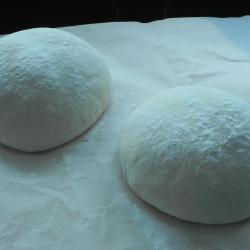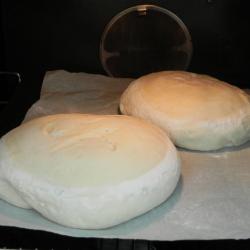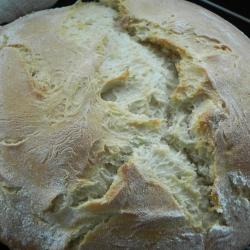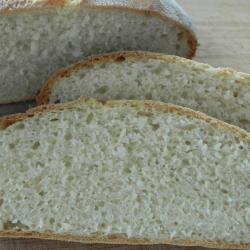
Pane alla ricotta is the final bread in the Verona and Tuscany section of Daniel Leader’s book Local Breads. As mentioned previously, this hasn’t been my favourite section as there have been no sourdough breads in it. This is the first section of totally yeasted bread, and it hasn’t exactly rocked my world! There really is something about sourdough! So I have made the first 20 bread recipes in this book, 8 have been yeasted and the remaining 12 sourdough (the croissants were a hybrid).
This was probably the most interesting bread in the section, the addition of ricotta is novel, and plus the loaf was tipped upside down after proofing and was baked belly up! I’ve never done that before. The ricotta cheese helped produce a velvety crumb and a subtle yet interesting taste to the bread, not exactly sweet, but it was something. The dough was unbelievably soft and billow, it was lovely.
So to the recipe, this was just yeasted dough, no biga required. We started with 200g water and 100g milk (both tepid), 20g instant yeast, 500g AP flour, 20g salt, 150g ricotta and 30g unsalted butter (I didn’t use any butter and decided to add the entire 250g tub of ricotta instead). This was all kneaded on my Kitchen Aid for about 12 minutes (nice and elastic). I then tipped it out, oiled the Kitchen Aid bowl and popped the dough back in to ferment (can’t stand making more dirty dishes than I need to!) for 1.5 hours at RT (about 18C). It had risen up nicely by this stage and deflated slightly when pressed.

Fermented dough
I tipped the dough onto a floured bench (rice flour) and cut it into 2 equal pieces of about 500g each. They were shaped into rounds and placed on a piece of baking paper to proof (covered with a plastic bag and tea towel) for about 1 hour.

Proofed loaves
The loaves were then gently flipped over so they were belly up and placed on baking paper on my peel. Since the dough was very soft, I had to be very carefully with the flipping, didn’t want to sucker punch them and knock out all their stuffing! The upside down loaves were then put on my stone in the 210C oven, and followed by 5 large ice cubes in the bottom tray. Baking time was 30 minutes.

Upside down loaves in oven
The loaves turned out a nice light golden colour, with a slight rift in the top where the shaping marks had split open during baking. Nice looking loaves. The crumb was reasonably closed as I would expect with the addition of the ricotta, and very soft. The bread was lovely with a variety of toppings including jam, marmite and avocado. I probably would make this bread again, as it was very pleasant dough to work with, even though the flavour while not hearty like a SD, was lovely.

Baked ricotta loaf

Ricotta crumb
Next up (this afternoon as it happens) is the first in the Genzano section – a SD loaf at last!
K.
Happiness is baking!




Replies
Hello Karnie,
I have done a number of recipes that were written for yeast and just substituted my normal quantity of starter/levain (say 180g) for the yeast (say 7/10g dry - 15/20g fresh) and adjusted the other flour and liquid ingredients to compensate for the content of it. Obviously, the bulk ferment and proving times will be different.
The results have been very acceptable.
Farinam
I've been enjoying following your adventures of baking thru Dan Leader's "Local Breads". I have the book and really need to crack it open & start baking some of his breads. I'm still a little shy around sourdough, as I feel I need to become a better yeast bread baker. So, now that I know he has a yeasted section, I will try some of his recipes.
Your bread looks delicious and so soft & with a chewy crust. Interesting the way he had you flip the bread so your seam showed on top & naturally cracked open in the oven. I must ask, what is marmite? Also, what hydration percentage do you like best for your SD baking? I'm finding this confusing, as some recipes call for 100% and others 166%.
Thanks for your comments :o)
There are a couple of breads in this section I'd make again but as sourdough Farinam - Rosemary Filone, olive cheeks and this ricotta loaf. They showd enough character as yeasted breads, that I think SD'ing them would make them even better.
Midnite Baker - I have a white starter at 50% (stiff), a white at 130% (liquid) and a rye at about 75% (thick paste), and use them all for different things. If you have a read of Local Breads, it tells you how to make all 3 and uses all 3 as well. So far in the book I have used all 3 starters - mostly the 2 white ones, but the spelt loaf used the rye (i think the only one so far that has). The loaf I made today Genzano country loaf suggested you could use any of the 3, and I used my stiff starter - I think I like it the best, no particular reason why. Myabe because my absolute favourite bread so far and the one I make the most often is the Quintessential sour dough, and that uses the stiff starter. In fact I made a double recipe of that today also for friends! Even managed to sneak in a round of golf as well! Mind you, I have just arrived home at 9pm, and am about to shape the aforemention loaves and put them in the fridge for an overnight proof ready for baking before work tomorrow!
Give SD a whirl! you'll love it! I'd never made a yeasted loaf before i started making SD. Try the pain de campagne or the quintessential SD - either is a great place to start.
Hope you didn't spend too much time at the 19th /;-{)}
Okay, 3 SD starters, thought I could get by with one and use Farinam's hydration formula spreadsheet for different hydrations. Found out what marmite is. My son & his friend are into microbrewing beer. With their contacts maybe someone has a recipe for making it. I'd love to try it sometime. Thanks for the help. Happy Baking. M